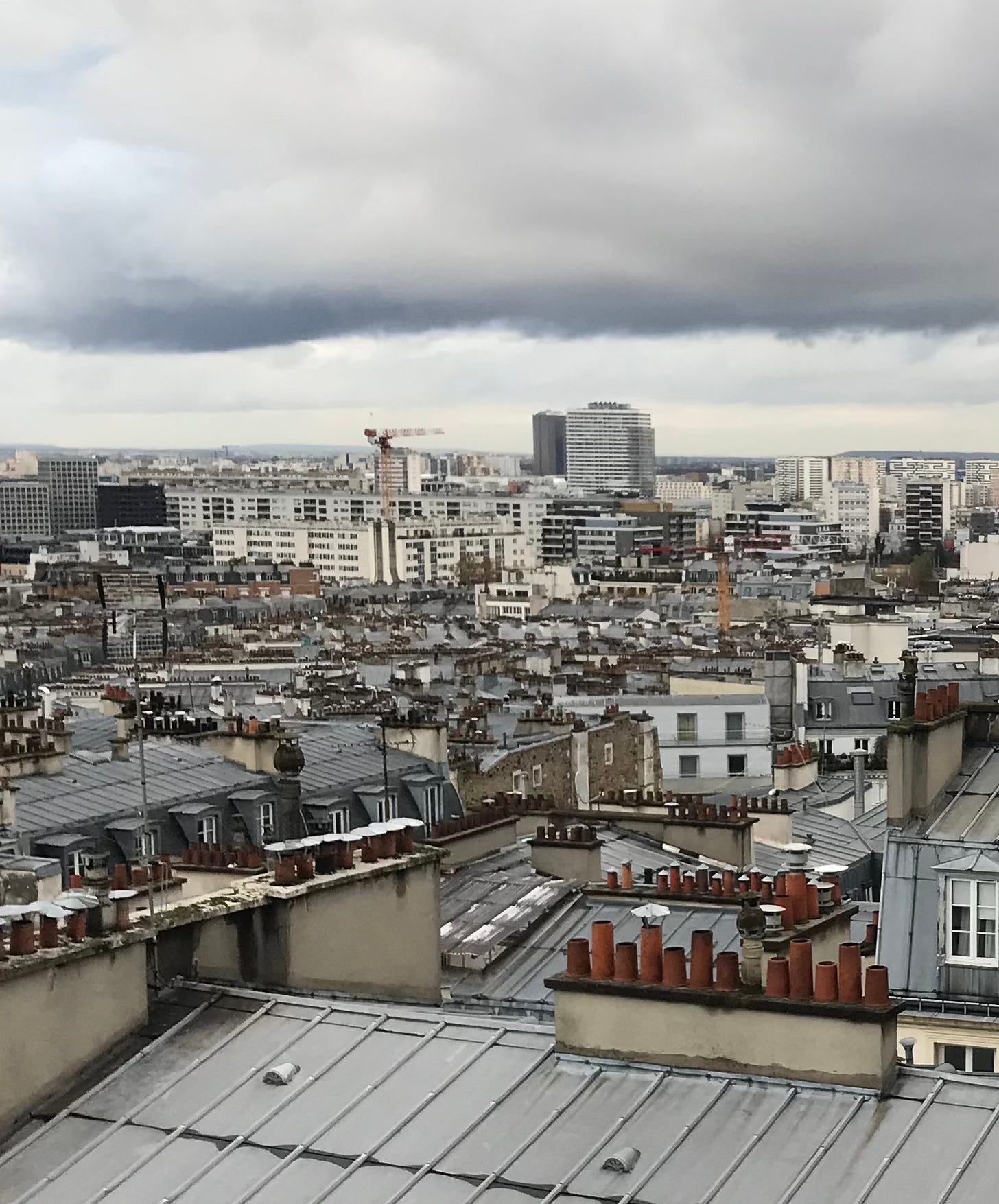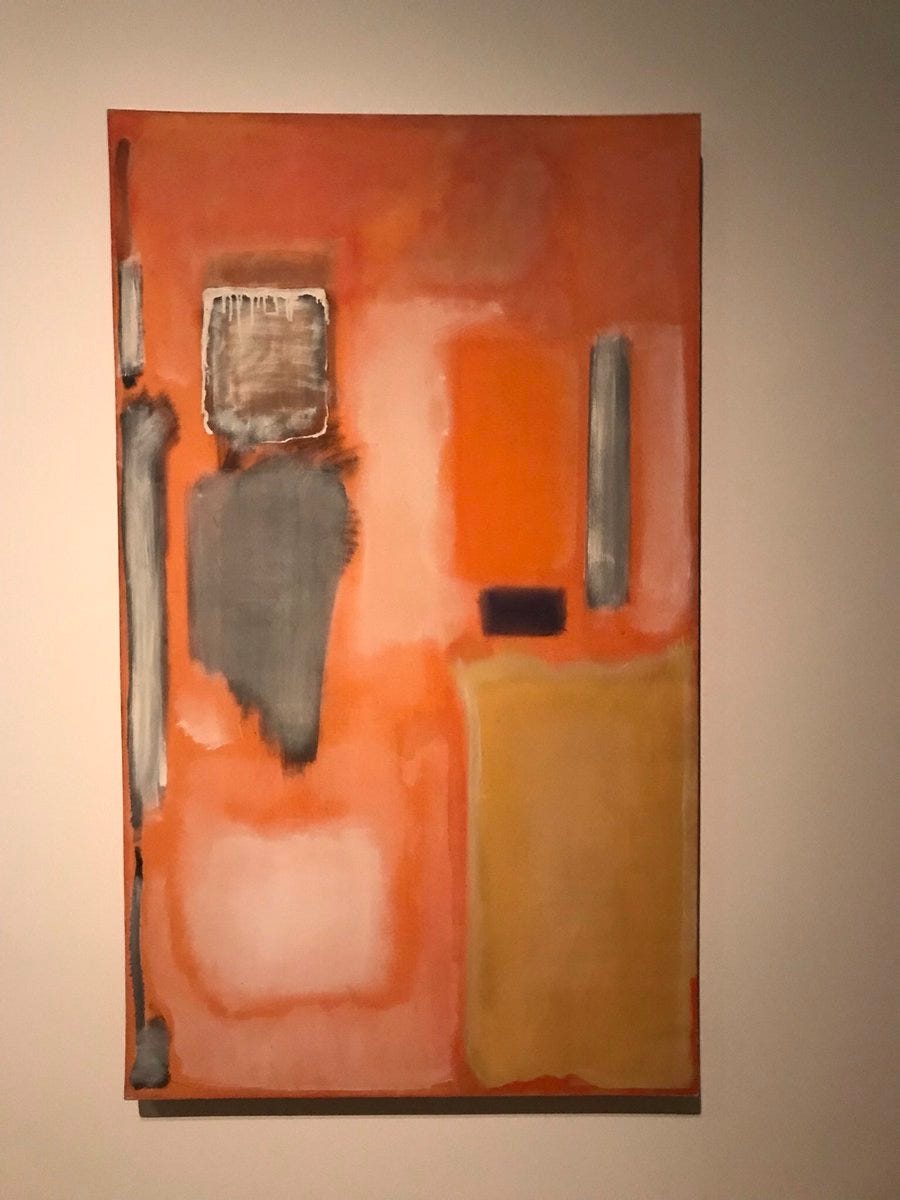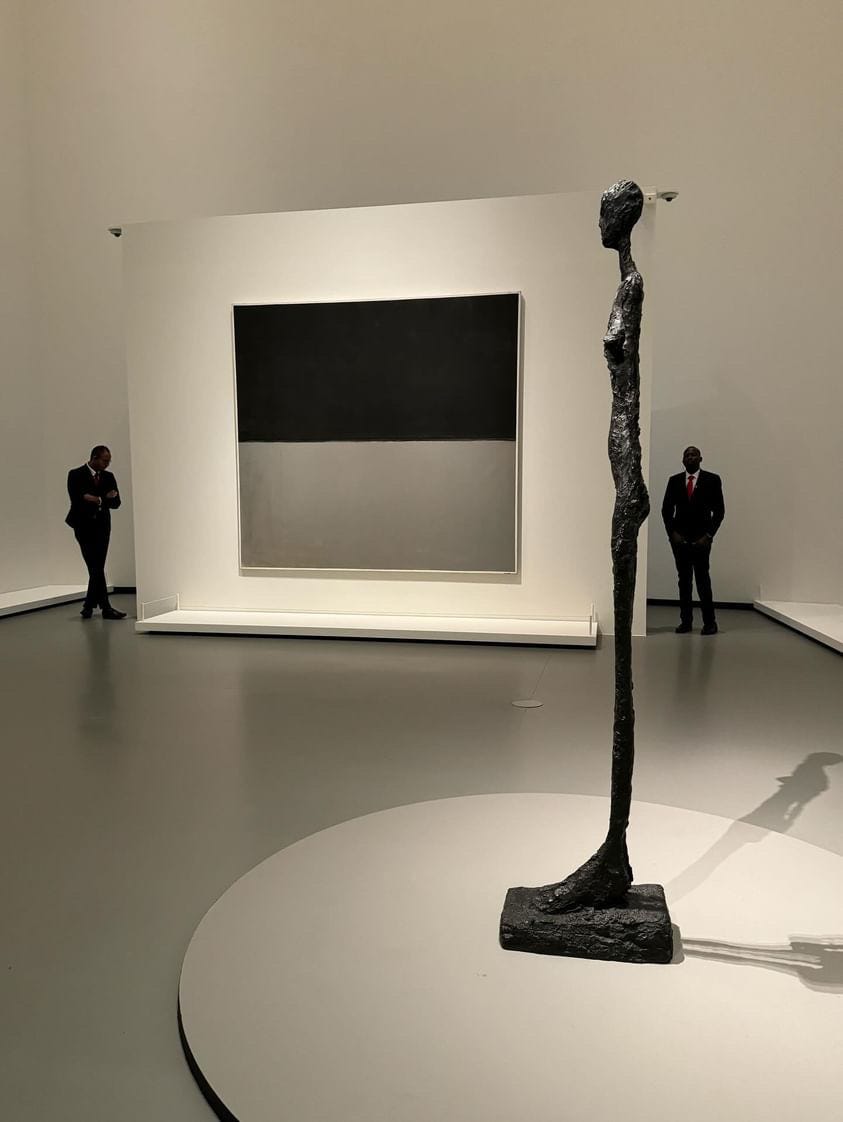Rothko
The huge Mark Rothko exhibition at the Fondation Louis Vuitton in Paris (closing 2nd April 2024) is a chronological journey through a hundred and fifteen works. And that’s just perfect; seeing his work evolve through his life is extraordinary.
I’d like to share the view from my room in Paris a day or two before I visited the Rothko exhibition; a view from the 18th arrondissement looking across the north east of the city beyond the peripherique and out towards Drancy. It was one of those days; the sky, the clouds, the buildings, the windows, the rooftops all appear to be shades of the same muted silver/grey.
It was if Paris had decided to give me a few things to think about before I could fully appreciate my visit to see the Rothkos. To appreciate the rectangles of muted colours. To look closer, to think harder about the juxtapositions of colour; the various dark terracotta chimney pots in the foreground, you’d think would be expressing some sludgy gloominess, but in this context they provide a brightness to the scene, even maybe shading to sunny orange.
Gaps are important. The empty spaces can have the deepest meaning. Could it be that what gives life and light to us isn’t necessarily heart shaped, it may be a narrow strip of sky dividing the disarray of the city from a block of darkening clouds?
I felt blessed to have that view, the rooftops. Paris, the wide sky, the city of possibilities. Nevertheless, the longer I lived with the view, the more I walked the streets around me, the more I was reminded that we can never know the secrets of a city. If I have my bearings right, somewhere out there is a cultural centre in La Chapelle where breakdancers entertained me one Sunday afternoon, and Zenith where I’ve seen Massive Attack play. But also I was looking at some of the poorer parts of the city. Under those evocative Paris rooftops; poverty, loneliness, violence. Above the rooftops, on so many days, the rain sweeping into the city from beyond the peripherique.
You see? The view from my room was revealing to me also that a landscape of rectangles in muted shades of grey can provoke emotion. Or emotions, rather - emotions which seem entangled, even contradictory. I’d discover this about Rothko - the longer you linger in front of one of his paintings, the less able you are to pin it down.
The view has a semi-connection with Rothko. In the history of Paris, the story of Drancy, on the horizon here, is a horror-show; in the Second World War it was where a transit camp was opened where Jews were imprisoned until they were deported to death camps. The first action took place on 20th August 1941, when 4,000 foreign and French Jews living in the Belleville and Menilmontant neighbourhoods were forcibly rounded-up and taken there. The round-ups were carried out by the French police, under the direction of the occupying Nazis.
Marcus Rothkovitch was born in 1903 in Dvirsk in what is now Latvia. When he was 10, his Jewish family escaped a different, earlier, organised massacres of Jews - the Russian pogroms - by emigrating to Portland, USA, before he moved on to attend a classes at the Art Students League of New York from 1923 (he took the pseudonym Mark Rothko in 1938).
I suspect the majority of Rothko prints in IKEA frames in households worldwide feature blocks of red, yellow, gold, ochre, orange. We appreciate the overwhelming and mysterious quality of a glorious yellow, and a shimmering orange. We want to hold on to light, to faith, to brightness.
The first room in the show at the Fondation Louis Vuitton has several of these works, which mostly date a from the second half of the 1950s. Up close to these large paintings, it’s noticeable that the colours aren’t laid on thickly and thoroughly like a well painted wall after three coats. The edges are blurry, the paint applied quickly. There’s even a sense of three dimensions; it’s like looking at veils of colour rather then blocks. This is the case throughout the exhibition. Even the darker paintings have a hint of insubstantiality about them. No clean, confident, mechanical Mondrian colours. The paint floats. I can see why Rothko said he imagined himself “breathing paint on to the canvas”.
The first room gives us recognisable Rothko. I think it’s fair to say we’ve have been lulled somehow into seeing Rothko’s works as ‘decorative’, one of Rothko’s least favourite descriptions of them (he wrote that they were “the opposite of decorative”). They remain mysterious to us, though, and, in their size, overwhelming in a way a poster could never be. Later in the show, this quality remains; the rectangles of deep inky blue from the early 1960s seem almost alive.
After the first room, the gallery reveals Rothko’s work in chronological order. We discover what came before the 1950s and what happened subsequently; the warm colours retreating, more sombre colours dominating, dark red, blue almost black, and maroon.
It’s not quite a straightforward progression towards darkness, but it’s clear how the the brightness fades, and, inevitably, we see this as a reflection of Rothko’s life. In 1970, after years of heavy drinking, subsequent poor health, and marital breakdown, he took his own life, an abrupt halt to an ever-evolving career.
It’s a treat to see the early works, both as pieces that work well, and as a part of the journey his art was to follow. Views of the New York subway, including ‘Entrance to the Subway’ (1938), share a similar atmosphere of urban isolation as Edward Hopper manifested in paintings of diners, streets, bedrooms (Rothko was a big Edward Hopper fan). But Hopper is all about smooth colour, details, but these colours are smudged, which, in the case of the faces, gives a slightly ghostly quality to the figures.
The travelers descending the stairs, and the group of passengers seen through carriage doors, seem to melt into a structure full of rectangles – the railings, the iron work, the train carriages. Areas of muted colour – the dirty yellow and blue of the pillars, for example - perhaps suggestive of Rothko’s later work; a way of seeing. Take the people away and maybe we glimpse what’s to come.
Rothko did decide to take the people away, at this moment withdrawing from figurative painting. His intentions; to portray emotion and poignancy without the presence of a human smile or gesture.
I know it’s sometimes considered old-fashioned or predictable to hang an exhibition of a single artist’s work in chronological order - it’s all the rage to present such shows thematically or alongside other artists’ responses etc - but it’s exactly what the experiments and developments of Rothko’s career require.
The very definition of his work is transition. He moves underground from station to station.
In this journey, perhaps inevitably, there’s a period which to me looks like a dead-end. I guess you’d call works like ‘Slow Swirl to the of the Sea’ (1944) “Surrealist”. There’s a fragility and hesitancy about these works but also an overly generic quality. An unconvincing phase.
It’s about a search for a voice, a style. Life changes, the context of an artist’s work is never still, connections with new people and new ideas grow or end. In 1982 New Order covered a reggae tune on a Peel session, a Keith Hudson song their late bandmate Ian Curtis had loved. I like it, it certainly has an intense atmosphere. Then they moved right on along.
Rothko’s so-called “Multiforms”, coming soon after the Surrealist work, were a thrill to see in the gallery. Created between 1947 and 1949, these paintings are an extraordinary step in Rothko’s development.
The fluidity, the impermanence, the forms dissolving, the sense of three dimensions, the mix of organic and metallic; all this I found fascinating. It’s as if someone left the subway painting out in the rain. Or took a drone shot of the remains of a battleground. Or whipped off their glasses at a party (Rothko had extremely poor sight, without his glasses he could barely see).
What you’re left with is a suggestion.
Rothko is stripping everything away now, he’s got his direction, his aim is unerring. Art historian and curator David Anfam says “There is more power in telling little than in telling all”. I find this to be true; the lack of bombast. The space. Things we don’t know. Soundtrack by Erik Satie.
Impatient, melancholic, cursed with depression, unenthusiastic about art critics, Rothko talking about his work tended to be disruptive; “I would like to say to those who think of my pictures as serene… that I have imprisoned the most utter violence in every inch of their surface,” for example.
He didn’t much want to talk about his art, on occasions he didn’t even want to sell his art; he hated being penniless, but also tended to be protective of his creations. In 1958, Rothko accepted a commission to paint a series of murals for a restaurant in the Seagram building (a Mies van der Rohe skyscraper in New York). The work he was producing at the time was intense, heavy; he began to conclude that the restaurant was an inappropriate location. In 1960, he cancelled the contract.
In his biography of Rothko, James E. B. Breslin reveals that the artist would almost literally clock on and clock off. Rothko told one his students that he liked the idea of getting off to his studio as if he was going to a job, and working a full day there, then at 5 or 6pm going home for dinner. There’s something admirable about a steadfast refusal to believe that an artist has to conform to the stereotype of staying in bed all day, or painting at night or whenever inspiration or intoxication takes hold. Instead, this mindset underlines the discipline that’s involved in the creative career. But more than any this, I’m guessing that it could be a conscious or unconscious way of dealing with depression; compartmentalise, develop a routine, take away unpredictability, give yourself control.
I’d suggest that Rothko’s remark to Life magazine in 1959 is the most valuable statement he ever made; “A painting is not a picture of an experience, it is an experience”.
“The audience complete the work” - this is something the film maker Carol Morley said to me the other day in conversation before a screening of her new film Typist Artist Pirate King. And that’s also the implication of Rothko’s remark.
But what does the audience bring to the work? In part, you’re looking at a mirror. I think that’s one of the attractions of a gallery. The experience of staring at a painting is a combination of seeing a view and looking in a mirror.
Protective of his work, Rothko had very precise ideas about his paintings should be displayed. The Fondation Louis Vuitton presents the work in low light, which was always Rothko’s preference, in order, he said, to appreciate “the poignancy of each work”. He believed his paintings should be encountered at close quarters; he got very precious and precise about this, and specifically, he recommended standing 18 inches from the canvas. In this way, you’d absolutely get a sense of being overwhelmed. Rothko doesn’t want detachment, he’d prefer a viewer to be drawn-in.
In the low light, even the work from the late 1950s into the 60s, the blues getting darker, a presence of a red - the red of a wine stain, or a blood stain - the paintings have a glow. Can something be both glowing and glowering? The works in the later galleries seem to be.
The contract to create the Seagram series ended, Rothko gave nine of the monumental works paintings intended for this commission to the Tate in London. This was 1969. The Fondation Louis Vuitton has the Seagram works on loan from the Tate in this exhibition. It’s this century’s definitive Rothko show.
In a final gallery titled “Black and Gray, Giacometti,” there are works from Rothko’s final series, “Black and Gray” (1969/70). His paintings are joined by sculptures by Alberto Giacometti, reflecting an idea that UNESCO pursued in 1969, of pairing of work by the two artists at its Paris HQ in 1969. A remarkable rendezvous to end the exhibition. It’s as if figures from the early Rothko paintings walked down the subway steps and out of Rothko’s vision, only to reappear in the world of Giacometti. Humans, you see. Stripped down, bleak, beautiful, walking but not moving, despairing but still standing.










Brilliant x
This is great!